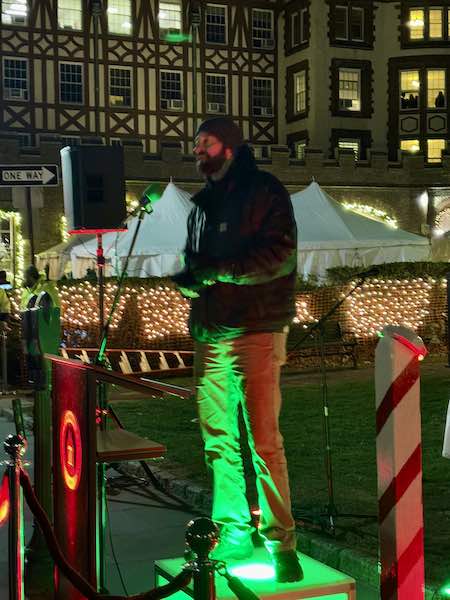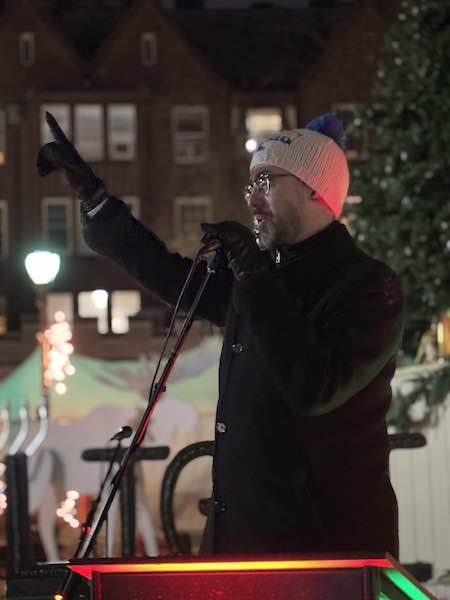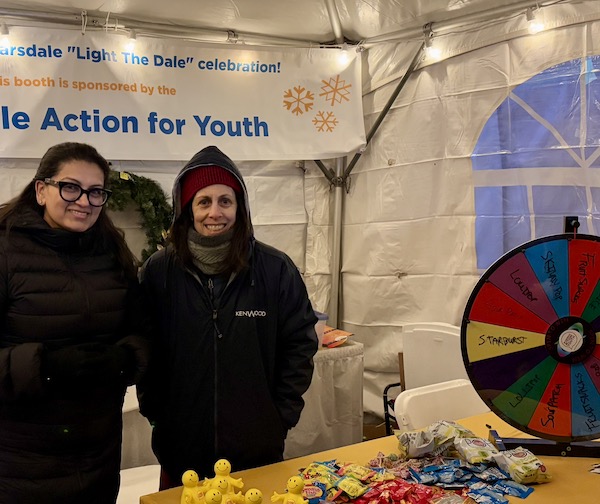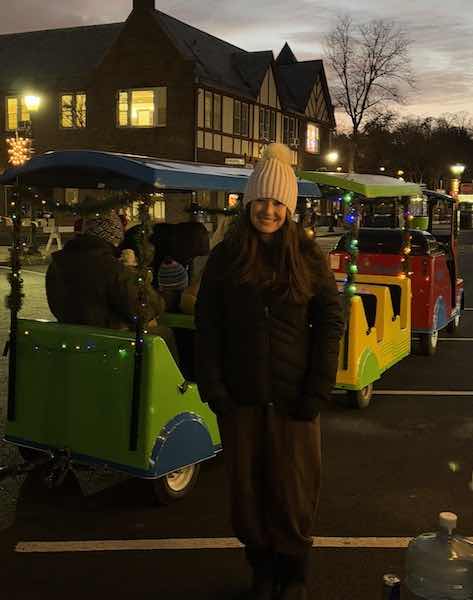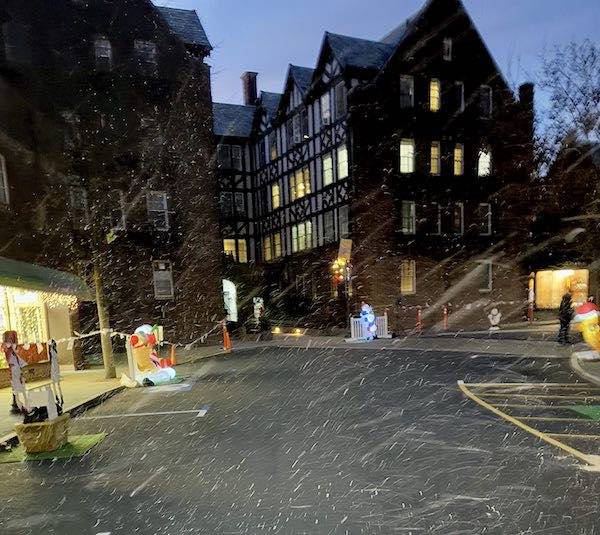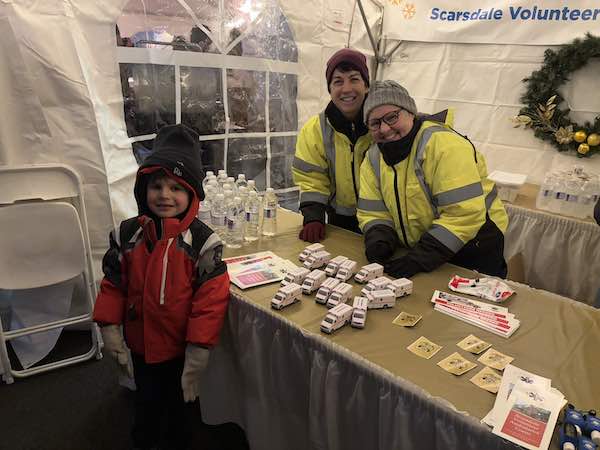New Rochelle Police Report Carjacking Incident and an Arrest for Animal Cruelty
- Details
- Written by: Joanne Wallenstein
- Hits: 2293
 On December 21 the New Rochelle Police Department received a report of a carjacking that occurred on Bridge Street. The incident involved a 21-year-old female resident of New Rochelle who was forcibly removed from her vehicle by unknown assailants.
On December 21 the New Rochelle Police Department received a report of a carjacking that occurred on Bridge Street. The incident involved a 21-year-old female resident of New Rochelle who was forcibly removed from her vehicle by unknown assailants.
At approximately 2:24pm on December 21st, the victim was waiting in her parked car for a friend when she was approached by at least two suspects. The perpetrators forcibly ejected the woman from her vehicle before stealing it and fleeing the scene. The victim reported that there may have been up to two additional suspects involved in the incident.
The victim was able to provide a limited description of one suspect, noting that he was wearing a bright-colored jacket. New Rochelle Police detectives are working diligently to gather more detailed descriptions and any available surveillance footage from the area.
Investigators believe this carjacking may be linked to an earlier incident on the same day, where a stolen vehicle was involved in a collision with two other cars before its occupants fled on foot. The connection between these events is currently under investigation.
The New Rochelle Police Department urges residents to remain vigilant and take precautions to ensure their safety, especially when alone in vehicles. We recommend keeping doors locked, being aware of your surroundings, and reporting any suspicious activity immediately.
Anyone with information related to this incident or the suspects involved is strongly encouraged to contact the New Rochelle Police Department at 914-654-2300. Anonymous tips can be submitted through our confidential tip line at 914-632-COPS.
Animal Cruelty
The New Rochelle Police Department, in collaboration with local ASPCA officers, has successfully concluded an investigation into a shocking case of animal cruelty, resulting in the arrest of a suspect.
On December 6th, 2024, a 41-year-old male New Rochelle resident reported to the police that his dog had been taken and killed by an acquaintance who was temporarily staying at his apartment. The complainant alleged that the suspect, identified as Benjamin Tyler, 39 years of age of New Milford, CT, had not only taken the dog but also dismembered it and disposed of the remains in various garbage locations around New Rochelle.
New Rochelle Police Detectives, working closely with ASPCA officers, immediately launched a thorough investigation into this disturbing incident. Their diligent efforts led to the acquisition of an arrest warrant for the suspect.
On December 23, 2024, Tyler turned himself in to the New Rochelle Police Department. He is currently in custody and facing charges related to animal cruelty.
The New Rochelle Police Department would like to remind the public that animal cruelty is a serious crime and will be prosecuted to the fullest extent of the law. We encourage citizens to report any suspected cases of animal abuse or neglect to local law enforcement or animal welfare organizations.
Arrested: Benjamin Tyler, 39 years of age, of New Milford, CT
Charges: New York State Agricultural and Markets Law Section: 353-A Aggravated Cruelty to Animals – Felony
Lawmakers Ask Federal Government to Identify Source of Drones over Westchester
- Details
- Written by: Joanne Wallenstein
- Hits: 1358
 (Updated December 18, 2024) It seems that our lawmakers are just as stumped as we are about the origin of the drones that have been sighted in Westchester, New Jersey and beyond.
(Updated December 18, 2024) It seems that our lawmakers are just as stumped as we are about the origin of the drones that have been sighted in Westchester, New Jersey and beyond.
On December 18, State Assemblymember Amy Paulin said,"I am in touch with the FBI. They are doing an active investigation and will get back to me and the Mayor when it is completed."
At a weekly media briefing on December 17, 2024, County Executive George Latimer read aloud the following letter that he has sent to President Biden asking the government to identify the source of the drones and publicize the facts.
See below:
Honorable Joseph R. Biden
President of the United States
The White House
1600 Pennsylvania Avenue, N.W.
Washington, DC 20500
Dear President Biden,
I have spoken to many throughout Westchester County who express fear and concern regarding the recent drone sightings. Residents are worried that their government is unable to identify these drones; they express trepidation over holiday travel to see and receive family, particularly from the Westchester County Airport, after Stewart International Airport in Orange County was shut down for an hour due to concerns over these drones. Our residents are in need of more information regarding these drones.
With an absence of answers, our residents are vulnerable to insidious conspiracy theories or solutions peddled by fringe ideologues. I believe, as I know you do, that it is our government’s responsibility to inform its people, and to protect them from those who would mislead them – intentionally or otherwise.
As such, I ask that your administration intervene to identify the source of these drones, and that your administration work to publicize the facts. In the documented cases where these drones have been manned aircraft operating within the boundaries of the law, I would ask that you further publicize these sightings; perhaps providing a clearinghouse to respond to the fear and misinformation which is filling the absence of a broader explanation.
I additionally support Senator Schumer’s proposed solution to deploy advanced drone detection technology; such technology would allow a more rapid response to issues similar to these in the future and could help identify these drones and alleviate many of our residents’ concerns.
As always, thank you for your tireless efforts on behalf of Westchester’s residents, and on behalf of our shared federal union.
Sincerely,
George Latimer
Westchester County Executive Congressman-elect for NYCD16
A Holiday Celebration in Scarsdale Village
- Details
- Written by: Sharon Higgins
- Hits: 1509
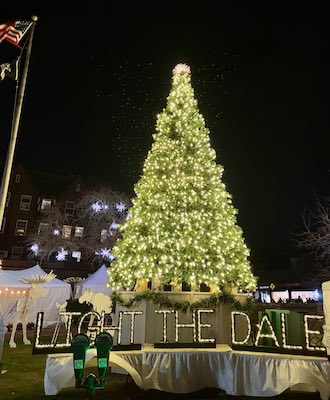 You couldn’t help but smile at the Light the ‘Dale tree lighting in Scarsdale Village on Friday night December 6, 2024. Young, old and everyone in between bundled up for the brisk 30 degrees weather but many felt it was preferable to last year’s rain. With hats, mittens, hot cocoa and warm pretzels, the chilly air was embraced.
You couldn’t help but smile at the Light the ‘Dale tree lighting in Scarsdale Village on Friday night December 6, 2024. Young, old and everyone in between bundled up for the brisk 30 degrees weather but many felt it was preferable to last year’s rain. With hats, mittens, hot cocoa and warm pretzels, the chilly air was embraced.
The celebration ceremony kicked off with Scarsdale High School’s A capella group For Good Measure singing a variety of holiday carols including Rudolph the Rednosed Reindeer. In their finale, they harmonized “Santa Claus is Coming to Town” as the original Santa rolled in on a big red firetruck. He greeted the crowd and went straight to the lottery hopper to pick a winner who would flip the switch on the holiday lights and tree. Sue Oricchio, from Scarsdale’s Recreation Department, commented that 110 children pre-registered to have their name on a ticket that was placed in the lottery hopper. Santa drew out the winning ticket and William Zhu, a 7 year-old Quaker Ridge resident who just turned 8 on December 8th, was selected for this honor. He was extremely excited and bounced to his spot up front by the switch waiting patiently for his cue.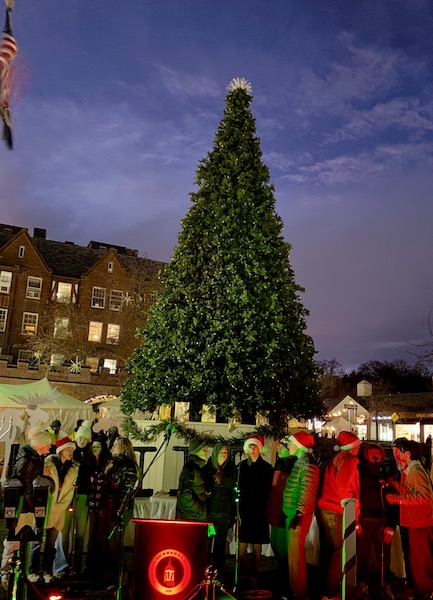 Christmas Carols from the SHS A Capella Group "For Good Measure:
Christmas Carols from the SHS A Capella Group "For Good Measure:
Brian Gray, Superintendent of the Recreational Department welcomed everyone to the evening's event and introduced Rabbi Blake of Westchester Reform Temple to give the holiday prayer. Mayor Justin Arest then thanked everyone for coming and for the Rec Department for organizing this wonderful event. He invited Scarsdale Police Department Chief Andrew Matturro to the podium to light the Menorah. Chief Matturro was recognized for this honor for his 36 year service on the force as he will retire next month. Still waiting patiently, it was finally William’s turn to switch on the lights. Ahhhhhh, went the crowd.
But that was only the beginning of the evening events. Adjacent to the now brightly lit tree, Santa stationed himself in a tent, in a big red chair next to a red sleigh while children and adults waited to tell him what they wanted for Christmas and take a photo too.
Tents lined Boniface Circle with holiday goodies like hot cocoa, hot pretzels, popcorn, food trucks, holiday stickers, face painting with artists from Team Fun Circus and an amazing horticultural activity sponsored by the Weinberg Nature  William Zhu lit the tree.Center. At this tent, children and adults could plant seeds and choose from native ferns, red clover and wildflowers, all non toxic and pet friendly. The wildflower option was by far the most popular.
William Zhu lit the tree.Center. At this tent, children and adults could plant seeds and choose from native ferns, red clover and wildflowers, all non toxic and pet friendly. The wildflower option was by far the most popular.
There was a Toys for Tots truck and further up Spencer Place was the Scarsdale Rec Department’s Polar Express Depot. Here children and parents waited for a ride that went down scenic Harwood Court with lighted blow ups lining both sides of the street. Right before the Polar Express circled back to the depot the riders would be hit with snow flurries making the trip magically festive.
The 2-hour event went very fast and was jam packed and full of excitement for the holiday season.
The only Grinch moment was the parking that was hard to come by.
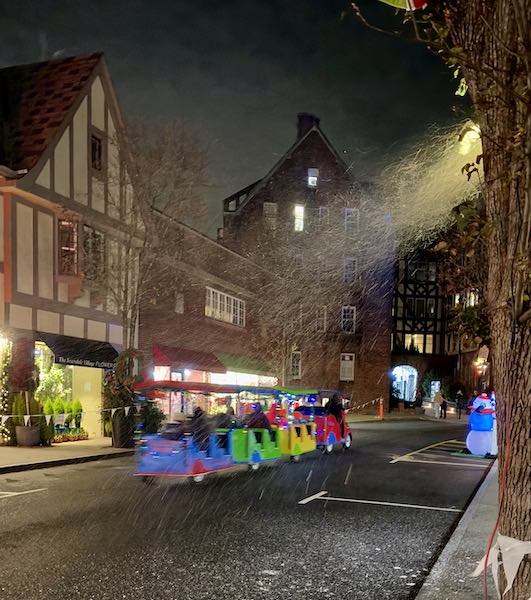 The Polar Express
The Polar Express
 Greenacres Third Grader Gigi Palese and her mom.
Greenacres Third Grader Gigi Palese and her mom.
Village Streets to Be Closed December 5 and 6 for Light the 'Dale Celebration
- Details
- Written by: Joanne Wallenstein
- Hits: 1402
 If you're planning to attend the Light the 'Dale tree lighting and celebration in Scarsdale Village at 5 pm on Friday, you might want to ask someone to drop you off. Due to street closures, parking will be very limited, and it will be tough to get a spot near the festivities.
If you're planning to attend the Light the 'Dale tree lighting and celebration in Scarsdale Village at 5 pm on Friday, you might want to ask someone to drop you off. Due to street closures, parking will be very limited, and it will be tough to get a spot near the festivities.
Here's an announcement from the Village of Scarsdale outlining street closings beginning on Thursday December 5 and extending through the event on Friday night through Saturday December 7, 2024 at 10 am.
Light the ‘Dale Celebration: Road Closures Thursday, December 05, through Saturday at 10 AM
In preparation for Scarsdale’s Light the ‘Dale event on Friday, December 06 in the Village Center, Boniface Circle will be closed starting at 5 AM tomorrow, Thursday, December 05 and will remain closed until Saturday, December 07 at 10 AM. Meter bagging in Boniface Circle will also occur at 5 AM on Thursday.
Meter bagging will occur on Chase Road between Christie Place and Popham Road at 9 PM on Thursday, December 05. The Village is bagging meters to prevent overnight parking. Please do not park in any space with a bagged meter, as such spaces must be vacant when the roads are closed.
Harwood Court at Spencer Place will be closed to vehicular traffic at 12 PM on Friday, December 06 and parking meters will be bagged. In addition, Chase Road between Christie Place and Popham Road will be closed at 2:30 PM. Closures on Spencer Place and Chase Road will remain in effect until the conclusion of the Light the ‘Dale event at approximately 7 PM on Friday, December 06. Meter bags will be removed at this time as well.
Be sure to join us Friday evening for this festive community event featuring music, food, and fun for all ages!
11 Candidates to Run for the 2025 SBNC Nominating Committee
- Details
- Written by: Joanne Wallenstein
- Hits: 1827
 The School Board Nominating Committee (SBNC) election will take place on Wednesday, December 4th, 2024, from 7 – 10 a.m. and 2 – 9 p.m. in the Scarsdale Middle School (SMS) Auditorium Lobby at 134 Mamaroneck Road.
The School Board Nominating Committee (SBNC) election will take place on Wednesday, December 4th, 2024, from 7 – 10 a.m. and 2 – 9 p.m. in the Scarsdale Middle School (SMS) Auditorium Lobby at 134 Mamaroneck Road.
A mail-in ballot is available for those who choose not to vote in person. Mail-in ballots are available to the public in hard copy at Scarsdale Village Hall and the Scarsdale Public Library, and available in electronic form on https://scarsdalesbnc.org/ starting Monday, November 25th, 2024.
Any resident of the school district who is (i) 18 years of age or older; and (ii) a resident of the school district for 30 days prior to the election (November 4, 2024) may vote in the SBNC Election.
Completed mail-in ballots must be sent to: SBNC Administrative Chair, PO Box 172H, Scarsdale, NY 10583, and received in the SBNC P.O. Box no later than 4pm on Tuesday, December 3, 2024.
Residents who are unable to access a ballot by either of these methods may contact the SBNC Administrative Committee Election Chair by email at SBNCElection@gmail.com for assistance. For more information about the SBNC, please visit https://scarsdalesbnc.com/.
The School Board Nominating Committee (SBNC) is a committee of residents elected from across the Village for the purpose of nominating candidates to fill vacancies on the Scarsdale Board of Education. Members are elected from each of the five elementary school districts to serve a term of three years on the Nominating Committee and two additional years on the Administrative Committee.
The Administrative Committee would like to encourage all Scarsdale residents to support the SBNC by voting in local elections, considering a candidacy, and making a contribution. The SBNC Administrative Committee runs the annual SBNC elections financed entirely by community support. Any contribution is greatly appreciated. Contributions may be made via Zelle and checks may be made payable to the “SBNC Administrative Committee” and mailed to P.O. BOX 172H, SCARSDALE, NY 10583. For more information please visit https://scarsdalesbnc.org/please-donate/
SBNC Continuing Members (Nominating Committee):
Terms Ending 2025
Edgewood – N/A
Fox Meadow – Kevin Chen, David Kirshenbaum, Susan Lee Greenacres – Arthur Rublin, Molly (Yue) Tu, Jocelyn Zoland Heathcote – Jacob Adlerstein
Quaker Ridge – June (Xun) Deng, Jennifer Simon Tabak
Terms Ending 2026
Edgewood – Shivi Bansal, Mimi Robinson
Fox Meadow – Adam Hellegers
Greenacres – Amadally Hosseinbukus, Lisa Purcell, Kristen Zakierski Heathcote – N/A
Quaker Ridge – Alissa Baum
SBNC Administrative Committee Members (2024-2025): Zachary Altschuler (FM), Treasurer; Sarah E. Bell (TVCC), Resolution Co-Chair; Lauren Hammer Breslow (HE); Kimberly Miller Champlin (HE); Lara Chassin (SNAP); David Fenigstein (GA), Webmaster; Lisa Gans (QR), SBNC Chair; Jennifer Goldfarb (HE); Beth Goldoff (SNAP); Claudia Green (FM); Kerry Hayes (Member at Large); Stephanie Israel (QR); Jon Lemle (SNAP), Resolution Co-Chair; Alan Meizlik (EW); Roger Neustadt (SNAP); Valerie Phillips (EW), Resolution Co-Chair; Stacey Strauss (QR); Christine Weston (EW), Election Chair; Meng Zhang (EW), Election Vice Chair; Anne Bates (EW), SBNC Vice Co-Chair, and Jennifer Zola (FM), SBNC Vice Co-Chair.
For additional information, please contact Christine Weston or Meng Zhang, at SBNCElection@gmail.com
Listed below are the candidates from each neighborhood with open seats* along with their biographies:
EDGEWOOD (3 candidates running for 4 positions)
JASON ANDRUS: 2 Taunton Road Length of Residency: 3 years Occupation: Digital Marketing Education: BS, Tulane University Child/Children’s ages: 7, 10
Civic Activities: Cub Scouts
BONING LIU: 45 Jefferson Road
Length of Residency: 6 years
Occupation: Civil Engineer
Education: (not provided)
Child/Children’s ages: 6, 12
Civic Activities: Board of Architectural Review (3 years), PTA Multicultural Committee, STEM Volunteer
NICOLE STERNBERG: 57 Carman Road Length of Residency: 15 years Occupation: Teacher
Education: BA, MA, St. John’s University Child/Children’s ages: 11, 16
Civic Activities: Class parent
HEATHCOTE (4 candidates running for 5 positions)
SIMON LIEBEL: 339 Heathcote Road
Length of Residency: 2.5 years
Occupation: Company Founder & CEO, Entourage Collection Education: BA, MA from Edinburgh University Child/Children’s ages: 8, 11
Civic Activities: Board Member, Think Global School
JOEL STEINHAUS: 53 Brookby Road
Length of Residency: 2.5 years
Occupation: Strategy Consultant
Education: BA, Harvard; MBA, Yale Child/Children’s ages: 10, 12, 14
Civic Activities: Appointed Elections Inspector
CINDY TRUE: 9 Seneca Road
Length of Residency: 3.5 years
Occupation: Real Estate Private Equity Investor
Education: BS, Civil Engineering, Columbia University
Child/Children’s ages: 1, 4, 6
Civic Activities: PULSES Volunteer (Parents United Learning the Special Education System)
CYNTHIA XIAOYUE LI: 8 Lebanon Road
Length of Residency: 2 years
Occupation: Attorney
Education: Georgetown University Law Center Child/Children’s ages: 4, 6
Civic Activities: Heathcote PTA Multicultural Committee FOX MEADOW (3 candidates running for 2 positions)
JEANNIE ADASHEK: 36 Tompkins Road Length of Residency: 5 years Occupation: Stay at home mom Education: St. John’s University Child/Children’s ages: 11, 14
Civic Activities: Fox Meadow PTA President, 2023-2024
DR. ELAINE WAN: 21 Olmsted Road Length of Residency: 2 years Occupation: Cardiologist Education: MIT, Columbia Child/Children’s ages: 5
Civic Activities: (not provided)
WENCHUN WU: 12 Parkfield Road Length of Residency: 5 years Occupation: Property Manager Education: Virginia Tech Child/Children’s ages: 7, 11
Civic Activities: Fox Meadow PTA Treasury Assistant
QUAKER RIDGE (1 candidate running for 3 positions)
JAYE WEISBROD: 3 White Birch Lane Length of Residency: 13.5 years Occupation: Stay at home mom Education: Masters’ Degree Child/Children’s ages: 13, 16
Civic Activities: PTA Scholarship Fund
*Greenacres Neighborhood does not have any open positions this year. Per the resolution, each neighborhood is to be represented by six committee members.











